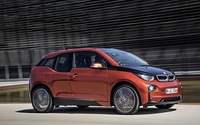2014 BMWi3 EV Introduction From John Heilig
THE AUTO PAGE REVIEW
By John Heilig
Model: 2014 BMW i3
Engine: Synchronous electric motor
Horsepower/Torque: 170 hp/184 lb.-ft. torque
Transmission: Automatic
Wheelbase: 101.2 in.
Length x Width x Height: 157.4 x 69.9 x 62.1 in.
Tires: P155/70R19
Cargo: 10 cu. ft. (est.)
Curb Weight: 2,630 lbs.
Sticker: $41,350 (base, plus $925 destination and handling)
The Bottom Line: The i3 survives the transition from concept car to production car, retaining all its quirky styling with the promised performance of a true electric car. Now if the infrastructure will only catch up
BMW introduced its all-electric i3 sedan to the media in coordinated productions in New York, London and Beijing. These cities were chosen because they have large urban populations and it is this audience that BMW wants to hear the message of the i3.
Except for the faux twin kidney grill, the i3 looks like no other BMW. This is the result of literally using a clean sheet of paper in the design. The i3 has a taller aspect ratio than the “average” BMW, and it’s significantly shorter. The clamshell doors and the absence of a B-Pillar are other clues to the difference.
However, inside the i3 there is room for four passengers, if cozily. The front seats are spacious, while the rear seats are tight. With a full-size adult in the front seat, I could only be comfortable in the seat behind it if I spread my legs out. I could do this because there is room around the sides of the front seats.
The frame of the i3 is made from carbon reinforced plastic that is produced in Washington State. While the car itself is made in Germany, it is a global car.
“The passenger cell is extremely strong and lightweight,” said Dr. Norbert Reithofer of BMW. “It will be an Ultimate Driving Machine.”
The i3 is unique in every respect. It signifies a new era of sustainable mobility, according to D. Reithofer. Besides being the first time reinforced carbon fiber is used in a car, the i3 also represents the first time sustainable materials are used in other areas of the car. For example, the fabric of the thin seats and the dash material are all organic. The dash is made of dried grass.
The engine sits in the rear of the i3 and propels the rear wheels, like a true BMW. The battery sits between the front wheels and the passenger compartment and is very low, giving good driving dynamics. With the carbon fiber frame and the aluminum space frame used for the drive motor, BMW is able to offset the weight of the battery by 230 kg. There is also a flat floor, aiding in making the interior livable. There is no tunnel and no center console.
Head of BMW design Adrian van Hooydonk said, “The proportions are unique. It has the most amount of interior space with a small footprint. It is taller than usual. The design should hold place with the modernity of the times.”
The i3 rides on narrow P155/70R19 tires. There is no spare. They are narrow because of aerodynamics. The body is made from injection mold thermoplastic. The rear of the car is black, but the tail lights show when they are on.
It is in the interior where the newness of the i3 is shown. Instead of a standard dash there are two flat screens. In front of the driver is a modern “instrument panel” while in the center of the car is an infotainment screen with a deep well in front of it. Each front seat has its own sun roof, a unique approach
Access to the rear seats is through a hatch-like opening seen in some small sedans/coupes. Once seated in the back, the rear passengers can’t exit without the front passengers opening their doors. Even with the hatch-like door, entry and egress are okay because of the absence of a B-Pillar. There’s a window behind the C-Pillar to reduce any closed-in feeling. It has a very nice trunk for its size.
In response to a reporter’s question, BMW executives said they fully expect the i3 to pass all federal crash tests.
BMW expects the i3 to have a range of 80 to 100 miles between charges. A “range extender” can be added that will add range up to as much as 140 miles. The range extender is a 650 cc two-cylinder gasoline engine that will charge the batteries.
BMW claims that the i3 has the footprint of a 1 Series, the interior space of a 3 Series and the materials of a 5 Series. There’s no question that it is very BMW-like, although not in the 7 Series class. There’s nothing cheap about it. With an estimated sticker price of around $42,000 before incentives, it is expensive for its size. But look at the money you’ll save at the gasoline pump, (if you drive the 30 miles per day the EV world is based on you will save almost $800 a year in fuel if compared to a 40 MPG vehicle, oops but the i3 costs 2x as much as a similar sized vehicle) The BMW i3 will be in dealerships in late 2014.
© 2013 The Auto Page



